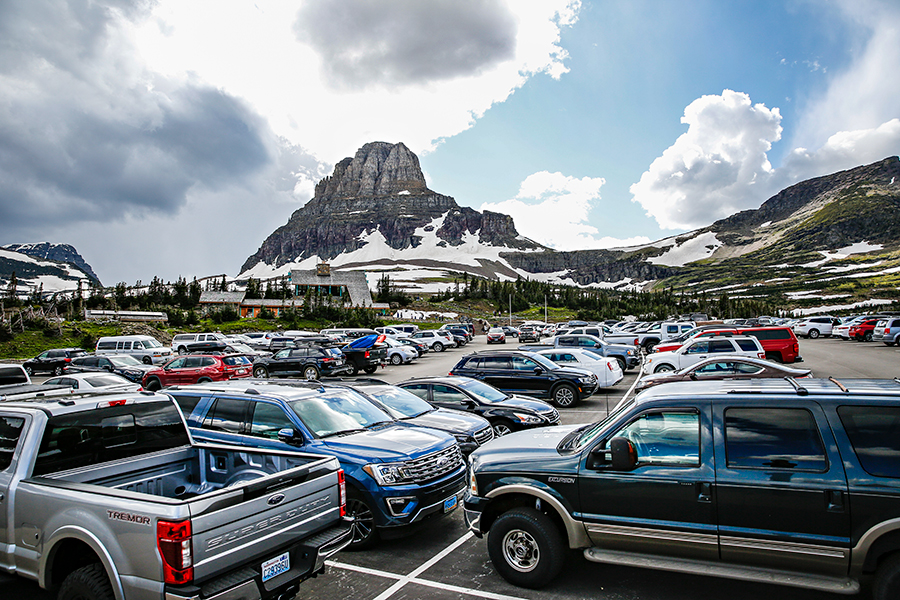
Going-to-the-Sun Road Corridor Management Plan Finalized
In the works since 2012, plan balances increased visitor use and resource protection along key corridor within Glacier National Park
Glacier National Park officials on Wednesday finalized the long-awaited Going-to-the-Sun Road corridor management plan to help improve the visitor experience and protect natural resources along the iconic alpine byway.
The comprehensive plan has been in the works since 2012 following unprecedented visitor use along the scenic corridor, and was crafted with broad input from the public. In 2019, park officials solicited formal public comments on the draft plan and its associated environmental assessment, releasing a “finding of no significant impact.”
In adopting the plan, park officials said it gives them the “tools” to handle skyrocketing visitation and allows them to “adaptively manage to changing conditions due to uncertainty.”
The plan identifies a range of management actions throughout the corridor and at specific locations, with the primary objective of managing congestion.
Potential management actions include expanding shuttle service along the entire Sun Road; implementing a partial parking permit system at popular locations like Logan Pass, St. Mary and the Virginia Falls Trailhead, as well as prohibiting overnight parking (thus preventing people from parking and going for a multiday excursion in the backcountry while taking up valuable parking lot space); constructing new parking lots on the east and west sides of the park; improving and adding trails and adding additional bathrooms in popular areas; improving services for bikers, including the addition of bike racks; during peak visitation, turning part of the Avalanche Creek Campground into additional parking; and extending visitor hours at the Apgar and St. Mary visitor centers.
The plan also suggests using a permit system on popular trails like the Highline to help limit the number of people on the trail during busy times of the year. While a permit system has been used for backcountry camping spots in Glacier, such a system has never been used to control access on trails in the park.
“The range of potential actions represents tools in a toolbox that the park can implement when certain triggers are met,” Park Superintendent Jeff Mow said. “There is no intention that the park would implement all the proposed actions at once or even implement them all over time.”
With the plan now final, park administrators will examine when and where to use the tools. Some actions require minimal preparation, such as adding bike racks or restriping existing pullouts, while others will require additional time and planning, such as adding parking and additional shuttle stops, Mow explained.
Similarly, many of the actions are meant to be adaptive, and will be evaluated regularly based on dynamic circumstances.
“The rapid nature of change in visitor use patterns, visitor demographics, technology, and conditions in the park calls for a much more adaptive and flexible set of management actions,” Mow added.
Indeed, throughout the planning period visitation increased at a rate even beyond what the original document envisioned, growing 40 percent between 2015 and 2017. In July 2017, visitation hit more than 1 million people in a single month. Total visitation that year was 3.3 million people, the highest on record. In 2019, the park recorded the second highest year for visitation with just over 3 million visitors.
In 2017, the park also began having to impose temporary closures at popular venues and access points such as the North Fork, Logan Pass and Many Glacier. During peak summer visitation periods, the Logan Pass parking lot has closed three times over the course of a day, with closures generally lasting a matter of hours.
Many of the challenges associated with congestion were exacerbated in 2020, when COVID-19 restrictions upended the visitor season and led to closures to the park’s eastern entrances, forcing park officials to manage Sun Road traffic as one way in, one way out for the first time in history.
Congestion challenges are expected to persist in 2021, even with the recently announced reopening of the east entrances, and park officials are considering using a ticketed-entry or reservation system to take the edge off the busiest summer months.
Although the final version of the corridor management plan did not recommend a reservation system, the park could still implement one this summer as an adaptive management strategy. Officials are expected to make a determination in the coming weeks.
Some submitted comments raised concerns that the final management plan omits the determination of a “carrying capacity” for the Sun Road, without which the plan’s site-specific strategies for mitigating crowds and congestion will not serve as long-term solutions.
Jack Potter, who worked in the park for more than 40 years before retiring as chief of science and resource management, wrote that the plan, by stopping short of determining a carrying capacity, fails to achieve its fundamental task.
“In reality, at times there are just too many visitors, that in aggregate contribute to overall road congestion, parking issues, and trail crowding, let alone resource impacts, and it appears it could get worse,” Potter wrote, urging officials to consider use limitation, particularly as it relates to private vehicle entry. “The issues may not go away with any comprehensive use limitation but the hot spots may improve or remain below thresholds and triggers. A comprehensive use plan, with use limitations is the first step to a real plan for the future, not merely addressing symptoms of crowding.”
A copy of the Going-to-the-Sun Road Corridor Management Plan Finding of No Significant Impact, as well as additional information about the planning process, can be found here.